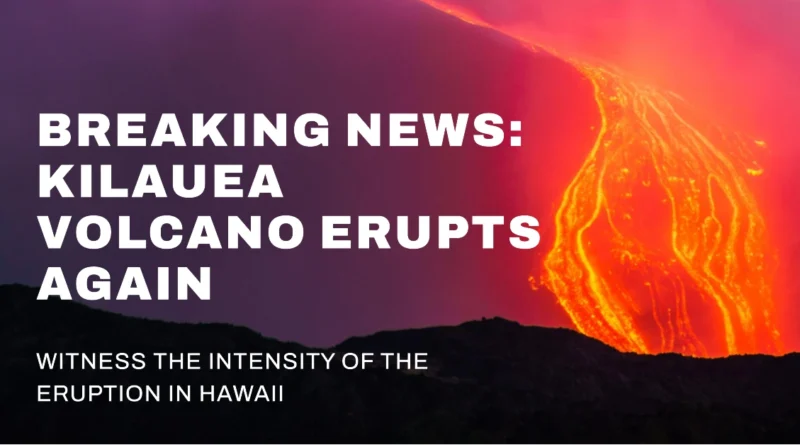Hawaii’s Kīlauea Volcano Erupts Again in 2023: An In-Depth Look
The Hawaiian Islands, known for their breathtaking natural beauty, are also home to one of the world’s most famous and active volcanoes – Kīlauea. In June 2023, Kīlauea erupted once more, capturing the attention of both locals and the global community. This eruption marked the third significant event of the year, following earlier eruptions in 2023. In this blog post, we will delve into the details of this fascinating geological event, its impact, and the ongoing research and monitoring efforts.
Kīlauea Volcano: A Geological Marvel
Kīlauea is a shield volcano located on the Big Island of Hawaii. It’s known for its near-constant volcanic activity, making it one of the most studied volcanoes in the world. This shield volcano has been erupting continuously since 1983, but its eruptions vary in intensity and impact.
Here are some key facts about Kīlauea:
| Fact | |
| 1 | Location: Big Island, Hawaii |
| 2 | Type: Shield volcano |
| 3 | Ongoing Activity: Yes |
| 4 | Recent Eruption: June 2023 |
| 5 | Monitoring Agency: U.S. Geological Survey (USGS) |
The 2023 Eruption: A Closer Look
In June 2023, Kīlauea erupted once again, demonstrating its unpredictable nature. This eruption was notable for several reasons:
| Aspect | |
| 1 | Renewed Lava Flows: The eruption resulted in fresh lava flows, creating mesmerizing yet potentially hazardous scenes. |
| 2 | Public Awareness: Local media played a significant role in keeping the public informed about the eruption, including safety guidelines and updates. |
| 3 | Impact on Hawaiʻi Volcanoes National Park: The eruption affected the Hawaiʻi Volcanoes National Park, altering visitor experiences and park operations. |
The Role of the Hawaiian Volcano Observatory
The Hawaiian Volcano Observatory (HVO) is a vital institution that monitors and studies Kīlauea’s activity. As an agency of the U.S. Geological Survey (USGS), HVO plays a crucial role in providing real-time information about volcanic eruptions.
Founded in 1912 by Thomas Jaggar, HVO has been at the forefront of volcanic research for over a century. Here are some key details about the observatory:
| Detail | |
| 1 | Founder: Thomas Jaggar |
| 2 | Headquarters: Hilo, Hawaii, U.S. |
| 3 | Address: Hawaii Volcanoes National Park, Crater Rim Drive, Hawaii 96718, United States |
| 4 | Phone: +1 808-967-7328 |
HVO operates under the USGS Volcano Hazards Program, and its mission is to provide real-time monitoring, research, and hazard assessments related to Hawaiian volcanoes, including Kīlauea.
Ongoing Research and Monitoring
Kīlauea’s eruptions offer invaluable opportunities for scientists to gain insights into volcanic behavior, hazards, and mitigation strategies. Researchers continuously monitor the volcano’s activity to:
- Understand Volcanic Processes: By studying Kīlauea’s eruptions, scientists can deepen their understanding of volcanic processes, helping to predict future events and protect communities.
- Evaluate Hazards: Volcanic eruptions can pose significant risks to human lives and property. Ongoing research aids in evaluating these hazards and developing effective mitigation plans.
- Advance Technology: Kīlauea’s ongoing eruptions drive the development of cutting-edge technology for volcanic monitoring and early warning systems.
- Educate the Public: Scientific findings from Kīlauea are used to educate the public about volcanic hazards and safety measures.
The Impact on Local Communities
While Kīlauea’s eruptions are a source of scientific fascination, they can also significantly impact the lives of those who call Hawaii home. The 2023 eruption was no exception, as it brought both challenges and opportunities to local communities.
Here are some key aspects of the impact on local communities:
- Evacuations and Displacement: Depending on the intensity and direction of the lava flows, residents in affected areas may need to evacuate their homes. This can be a challenging and emotional experience, as families are temporarily displaced from their neighborhoods.
- Economic Impact: The eruption’s effects on the tourism industry, agriculture, and local businesses can be substantial. Tourism, in particular, may see fluctuations as visitors are drawn to witness the volcanic activity or, conversely, stay away due to safety concerns.
- Community Resilience: The resilience of local communities in the face of eruptions is remarkable. Residents often come together to support each other, share resources, and rebuild after the lava has receded.
- Scientific Engagement: The eruptions can also provide opportunities for scientific outreach and education. Local schools and organizations may take advantage of the heightened interest in volcanoes to educate the public, especially students, about geology, volcanology, and disaster preparedness.
Responding to Eruption Challenges
The eruption of Kīlauea, like any volcanic event, presents challenges that require coordinated responses from various agencies and organizations. Key actions include:
- Emergency Services: Local authorities and emergency services play a crucial role in ensuring public safety during eruptions. Evacuation plans, emergency shelters, and response teams are essential components of their efforts.
- Volcano Monitoring: Agencies like the Hawaiian Volcano Observatory (HVO) continuously monitor Kīlauea’s activity. Their real-time data and hazard assessments are invaluable for making informed decisions regarding evacuations and safety measures.
- Community Support: Non-profit organizations and community groups often step in to provide support for displaced residents. This can include providing food, shelter, and emotional assistance during challenging times.
- Scientific Research: Scientists and researchers seize the opportunity to collect data during eruptions. This information contributes to a deeper understanding of volcanic processes and can inform hazard mitigation strategies.
Lessons Learned
Kīlauea’s eruptions, while disruptive, have provided valuable lessons for volcanic risk management. Here are some key takeaways:
- Early Warning Systems: Developing and maintaining robust early warning systems is crucial for mitigating the impact of volcanic eruptions. These systems rely on real-time data and monitoring to provide timely alerts to affected communities.
- Community Preparedness: Communities near active volcanoes must be well-prepared for possible eruptions. This includes having evacuation plans, emergency kits, and knowledge of evacuation routes.
- Scientific Collaboration: Volcanologists and geologists from around the world often collaborate during eruptions. This international cooperation enhances our understanding of volcanic behavior and hazard mitigation.
- Resilience Building: Local communities have shown remarkable resilience in the face of eruptions. Building on this resilience by fostering community cohesion and preparedness is essential.
The Ongoing Story of Kīlauea
As we reflect on the 2023 eruption of Kīlauea, it’s important to recognize that this remarkable volcano’s story is far from over. Its unpredictable eruptions and breathtaking landscapes will continue to captivate scientists, residents, and visitors alike.
For those who live in its shadow, Kīlauea serves as a reminder of the dynamic forces that shape our planet and the need for continued research and preparedness. It’s a testament to the enduring spirit of the Hawaiian people and their ability to adapt to the ever-changing conditions of their beautiful island home.
So, as we watch the plumes of smoke and molten lava, let us also appreciate the resilience, scientific curiosity, and sense of community that thrive in the shadow of this extraordinary volcano.
Conclusion
Kīlauea’s eruptions are not just geological events; they are also windows into the complex and dynamic processes that shape our planet. The 2023 eruption, while captivating, reminds us of the importance of continued research and monitoring to ensure the safety of those living near active volcanoes. Thanks to institutions like the Hawaiian Volcano Observatory and the dedication of scientists, we can learn from these natural wonders and work towards a safer future.
As we marvel at the beauty and power of Kīlauea, let’s also appreciate the hard work and dedication of those who study and monitor this remarkable volcano, contributing to our understanding of Earth’s ever-changing landscape.




